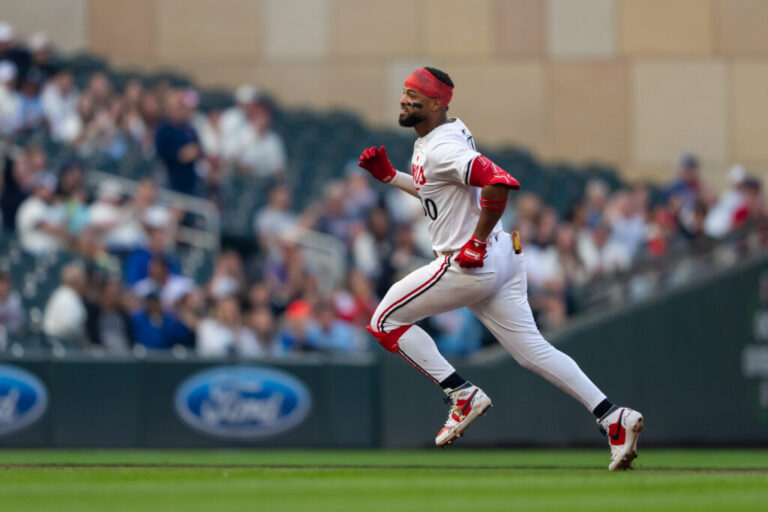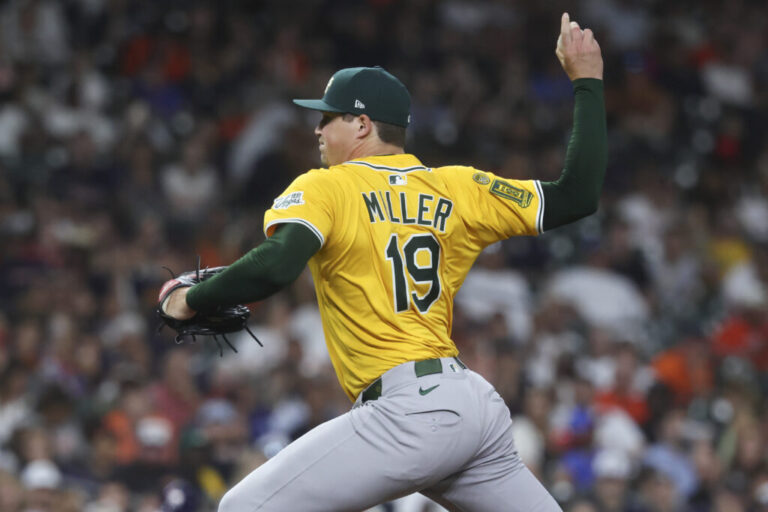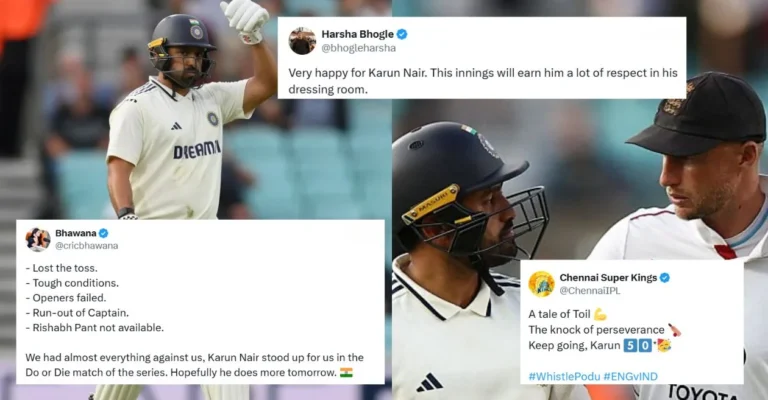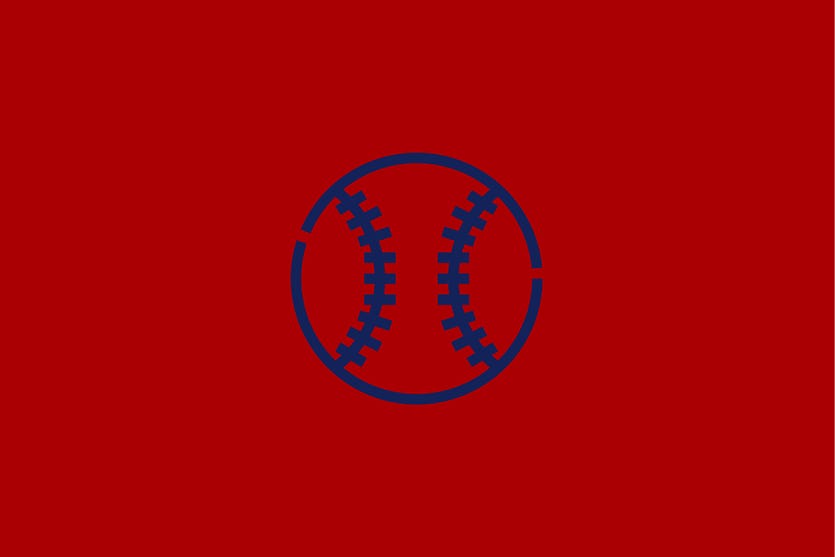
Most pundits — particularly those based in New York — seem ready to hand the American League’s Most Valuable Player Award to Aaron Judge or Juan Soto.
They should be paying more attention to Bobby Witt Jr.
The Royals shortstop was tied with Soto for the major-league lead with 83 runs scored at the season’s 17-week mark (July 24), and he was one of only nine batters with at least 70 runs batted in.
And isn’t run production the very aim of the game?
Witt, as a matter of fact, ranks as the American League’s leader in scoring (SC), outpacing the two Yankees outfielders, Judge and Soto.
SC is calculated by adding runs and RBIs, and then subtracting home runs. (Homers are tabulated in both the R and RBI columns. Subtraction keeps them from being double-counted.)
The math for Witt works this way: 83 runs scored are added to 70 runs batted in, with 18 homers subtracted. The result is an SC of 135, the highest total in the majors. Judge and Cleveland third baseman Jose Ramirez are tied for second in the AL with scores of 130.
The National League’s scoring leader is Shohei Ohtani of the Los Angeles Dodgers, who has established himself as the consensus frontrunner for his league’s MVP trophy. Ohtani’s SC of 121 is seven ahead of teammate Freddie Freeman.
Here are the 10 top scorers in each league after 17 weeks of play:
-
1. Bobby Witt Jr., Royals, SC 135
-
2. Aaron Judge, Yankees, SC 130
-
2. Jose Ramirez, Guardians, SC 130
-
4. Juan Soto, Yankees, SC 129
-
5. Gunnar Henderson, Orioles, SC 116
-
6. Jarren Duran, Red Sox, SC 111
-
7. Josh Naylor, Guardians, SC 105
-
8. Rafael Devers, Red Sox, SC 104
-
8. Marcus Semien, Rangers, SC 104
-
10. Maikel Garcia, Royals, SC 100
-
1. Shohei Ohtani, Dodgers, SC 121
-
2. Freddie Freeman, Dodgers, SC 114
-
3. Marcell Ozuna, Braves, SC 113
-
4. Ketel Marte, Diamondbacks, SC 112
-
5. William Contreras, Brewers, SC 111
-
6. Francisco Lindor, Mets, SC 107
-
6. Christian Walker, Diamondbacks, SC 107
-
8. Willy Adames, Brewers, SC 106
-
8. Brandon Nimmo, Mets, SC 106
-
10. Alec Bohm, Phillies, SC 105
If we want to flip the script and identify baseball’s least efficent run producers, we can’t simply look at the bottom of the scoring standings.
More than 100 players — mostly those who played a handful of games — had SC totals of zero at the 17-week mark. They hadn’t been given sufficient opportunities to show what they can do.
I’ve taken a different approach in my search for scoring laggards. I’ve limited the rankings to batters with at least 200 plate appearances. Their scoring totals are expressed as ratios per 100 PA, a stat labeled as scoring rate (SCR).
The worst rate belongs to Tim Anderson, who played shortstop for the Miami Marlins until they jettisoned him in early July.
Anderson scored 16 runs and drove home nine more, giving him an SC of 25. (He didn’t hit any homers win his 241 appearances.) That translates to a ratio of 10.37 runs per 100 plate appearances, the worst SCR in the majors (and the National League) this year.
Eloy Jimenez of the White Sox has the lowest scoring rate in the AL, 12.07 per 100. (The best SCR, if you’re curious, is 30.52 per 100 by Jose Ramirez of the Guardians.)
Here are the five worst ratios in each league:
-
1. Eloy Jimenez, White Sox, SCR 12.07
-
2. Jorge Polanco, Mariners, SCR 12.55
-
3. Nicky Lopez, White Sox, SCR 12.96
-
4. Seth Brown, Athletics, SCR 13.48
-
5. Andrew Benintendi, White Sox, SCR 13.92
-
1. Tim Anderson, Marlins, SCR 10.37
-
2. Nick Fortes, Marlins, SCR 12.32
-
3. Orlando Arcia, Braves, SCR 13.17
-
4. Miguel Amaya, Cubs, SCR 13.43
-
5. Enrique Hernandez, Dodgers, SCR 13.85
The recent addition of Adrian Beltre, Todd Helton, Jim Leyland, and Joe Mauer has increased the National Baseball Hall of Fame’s number of honorees to 346.
Cooperstown’s induction rate has held fairly steady in recent decades, with 40 new members being welcomed in the 1990s, another 45 during the first 10 years of the current century, and 40 more in the 2010s.
Those figures pale in comparison to the single-decade record of 55 inductees in the 1970s. Here’s a look at the hall’s induction trends since the first election in 1936.
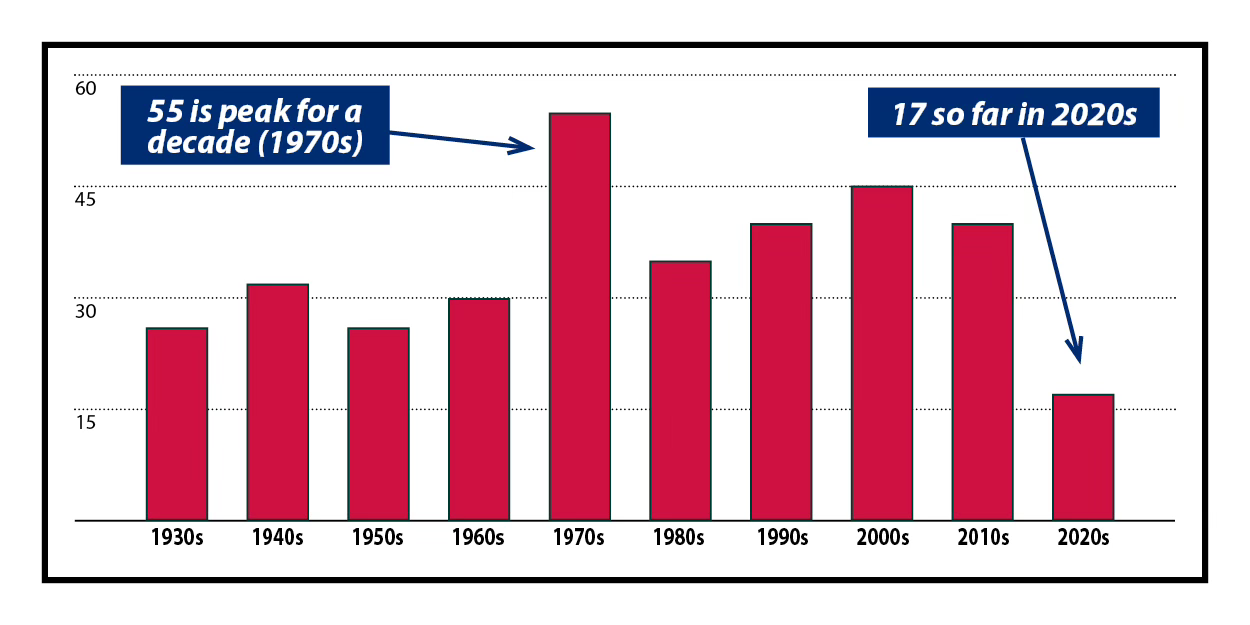
A new installment will arrive in your email each Tuesday morning
Casey Stengel was born in Kansas City on July 30, 1890 — precisely 134 years ago today. This week’s quiz salutes the Hall of Fame manager who also had a decent (if unremembered) career as a player. Scroll to the bottom of this newsletter to find the answers.
1. Stengel broke into the majors as a player in 1912 and stuck around until 1925. What position did he play?
-
A. Pitcher
-
B. Catcher
-
C. Shortstop
-
D. Right fielder
2. Stengel starred in the 1923 World Series. He scampered to an inside-the-park home run to win Game One, then he homered again to produce the only run in a 1-0 Game Three triumph. Which team did he play for?
-
A. Boston Braves
-
B. Brooklyn Dodgers
-
C. New York Giants
-
D. New York Yankees
3. Stengel was not an immediate success as a manager. He ran the Brooklyn Dodgers for three years (1934-1936), followed by six seasons (1938-1943) at the helm of the Boston Braves. How many of those nine clubs finished above .500?
-
A. Three
-
B. Two
-
C. One
-
D. None
4. Stengel’s great success came with the Yankees from 1949 to 1960. How many world titles did he win?
-
A. Eight
-
B. Seven
-
C. Six
-
D. Five
5. Stengel’s swan song came with the expansion Mets from 1962 to 1965. He retired in the middle of the fourth season. What was the fewest number of losses suffered by the Mets in any of his three full years?
Most longtime baseball fans are accustomed to losing.
Only 10 major-league franchises have piled up more victories than defeats during the Modern Era. That means a substantial majority of teams — 20 of 30 — have lost more than half of their games since 1961.
The New York Yankees are the biggest exceptions to the rule. They notched 5,579 victories between 1961 and 2023, easily outdistancing their 4,378 defeats. The Yanks’ 63-year winning percentage of .560 is the period’s best. (Games from the current season aren’t included in these stats.)
The Los Angeles Dodgers and Boston Red Sox are the runners-up with respective Modern Era winning percentages of .549 and .531. Here are the 10 teams above .500:
-
1. Yankees, 5,579-4,378 (.560)
-
2. Dodgers, 5,469-4,501 (.549)
-
3. Red Sox, 5,293-4,674 (.531)
-
4. Cardinals, 5,277-4,678 (.530)
-
5. Braves, 5,188-4,763 (.521)
-
6. Giants, 5,152-4,819 (.517)
-
7. Reds, 5,120-4,843 (.514)
-
8. Orioles, 5,074-4,877 (.510)
-
9. Athletics, 5,003-4,966 (.502)
-
10. Astros, 4,921-4,892 (.501)
The Detroit Tigers didn’t play their best baseball during the week of July 23-29, 1984, yet they widened their lead in the American League East just the same.
The ’84 Tigers, who rank as the greatest team of the Modern Era, went 4-3 over the seven-day period. They took two of three games from the Cleveland Indians, then split a four-game set with the Boston Red Sox.
Detroit started the week with a nine-game lead over second-place Toronto, but the Blue Jays fell into a six-game losing streak, their worst of the year. The Tigers consequently held a comfortable 12-game margin on the morning of July 30.
Catcher Lance Parrish advised his teammates — and the fans — to stop worrying about the Jays.
“I don’t care about Toronto,” he said. “They’re losing. I care about us. This is make-or-break time for our attitude. We have to maintain the killer instinct.”
The 1962 New York Mets, well on their way to becoming the Modern Era’s losingest team, stayed true to form between July 23 and 29.
The Mets dropped their first three games of the week to the Milwaukee Braves, extending an ongoing losing streak to 11. They broke the string with a 1-0 shutout of the St. Louis Cardinals, with New York’s Al Jackson outpitching future Hall of Famer Bob Gibson. And then they reverted to their losing ways, dropping three of their next four games with the Cards.
The National League standings on July 30 had the Mets deep in last place, 43 games behind the frontrunning Los Angeles Dodgers.
1-D. (Stengel played all three outfield positions, but spent most of his time in right.)
2-C. (Stengel batted .417 for the Giants in the 1923 World Series. But his homers produced his club’s only two victories. The Giants lost to the Yankees in six games.)
3-C. (The 1938 Boston club, temporarily renamed as the Bees, went 77-75. It was Stengel’s only appearance above .500 for his first two managerial employers.)
4-B. (Stengel won seven world championships with the Yanks. The first five came in succession: 1949-1953. He added World Series titles in 1956 and 1958.)
5-C. (The Mets’ successive numbers of defeats were 120 in 1962, 111 in 1963, and 109 in 1964.)
